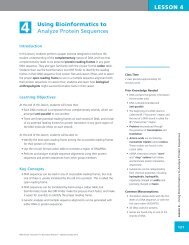WET LAB DNA Barcoding: From Samples to Sequences - Northwest ...
WET LAB DNA Barcoding: From Samples to Sequences - Northwest ...
WET LAB DNA Barcoding: From Samples to Sequences - Northwest ...
Create successful ePaper yourself
Turn your PDF publications into a flip-book with our unique Google optimized e-Paper software.
<strong>WET</strong> <strong>LAB</strong><br />
Lab 3: Analyzing PCR Results<br />
with Agarose Gel Electrophoresis<br />
Teacher Preparation<br />
• Load the classroom computer with the Wet Lab PowerPoint slides.<br />
• Make copies of the Student Handout—Analyzing PCR Results with Agarose<br />
Gel Electrophoresis, one per student. These handouts are designed <strong>to</strong> be<br />
reused as a class set; students write answers <strong>to</strong> questions and take notes on a<br />
separate sheet of paper or in their lab notebook.<br />
• Teachers may wish <strong>to</strong> have their students write out the lab procedures before<br />
the activity in their lab notebooks or on a separate piece of paper as a “prelab”<br />
exercise, which can be used as an “entry ticket” <strong>to</strong> class. During the<br />
lab, students may check off steps as they complete them and/or describe and<br />
draw pictures of their observations.<br />
• If students are not familiar with agarose gel electrophoresis, queue your<br />
computer <strong>to</strong> one or more of the following tu<strong>to</strong>rials:<br />
‣ “How <strong>to</strong> Make and Run an Agarose Gel (<strong>DNA</strong> Electrophoresis)” by<br />
labtricks.com (4:54 min) includes how <strong>to</strong> calculate percent agarose, make<br />
and pour an agarose gel, a close-up of sample loading on the gel, and<br />
running the gel: http://www.youtube.com/watch?v=2UQIoYhOowM.<br />
‣ “Loading a Gel for Electrophoresis” by Carolina Biologicals (5:46 min)<br />
includes different types of pipettes used and a close-up of the proper<br />
techniques <strong>to</strong> load a pre-poured agarose gel. [Note: The first 2:50 min of<br />
the video covers loading a gel with a micropipette.]: http://www.youtube.<br />
com/watch?v=h06rz8rcZpw&feature=related.<br />
‣ “<strong>DNA</strong> Electrophoresis Sample Loading” from Greg Peterson, Coordina<strong>to</strong>r of<br />
Biotechnology, Kirkwood Community College, Math/Science Department,<br />
includes pouring the agarose gel, preparing the <strong>DNA</strong> samples for loading<br />
on the gel, and close-ups of the “do’s and don’ts” of loading <strong>DNA</strong><br />
samples on gels, including a number of common mistakes. [Note: The<br />
first 1:00 min of the video moves quickly, and the voice-over does not<br />
precisely match the video content; however, the sample loading examples,<br />
beginning at 1:04 min, are extremely helpful. If this video is not shown<br />
<strong>to</strong> students, teachers may want <strong>to</strong> review it <strong>to</strong> anticipate and evaluate<br />
common gel loading problems encountered by students.]: http://www.<br />
youtube.com/watch?v=tTj8p05jAFM&feature=related.<br />
• Set up student work stations by distributing supplies and reagents needed<br />
for each group, as described above under Materials. It is suggested that<br />
reagents be aliquoted for student groups and labeled as described in<br />
Student Handout—Analyzing PCR Results with Agarose Gel Electrophoresis.<br />
This information is found in Teacher Resource—Aliquoting <strong>DNA</strong> <strong>Barcoding</strong><br />
Reagents for Labs 1–4.<br />
• Visualizing <strong>DNA</strong> Gels with Fast Blast <strong>DNA</strong> Stain. <strong>DNA</strong> gels can be<br />
stained quickly (i.e., in less than 20 minutes) with 100X Fast Blast <strong>DNA</strong><br />
stain or overnight with 1X Fast Blast <strong>DNA</strong> stain. Students are instructed in<br />
Student Handout—Analyzing PCR Results with Agarose Gel Electrophoresis <strong>to</strong><br />
[Note: Students often confuse the tubes<br />
for the loading dye and the molecular<br />
weight standard. Both are in small, 1.7<br />
ml microfuge tubes, and both are blue.<br />
Teachers may wish <strong>to</strong> only set out the<br />
loading dye, and hand out the molecular<br />
weight standard after all samples have been<br />
prepared. If students have no bands in their<br />
molecular weight standard lane, they may<br />
have loaded dye instead of the molecular<br />
weight standard. If there are many bands<br />
in their sample wells, they may have mixed<br />
their samples with molecular weight<br />
standard instead of loading dye.]<br />
[Note: Fast Blast <strong>DNA</strong> Stain can be<br />
re-used up <strong>to</strong> 7 times.]<br />
Wet Lab – <strong>DNA</strong> <strong>Barcoding</strong>: <strong>From</strong> <strong>Samples</strong> <strong>to</strong> <strong>Sequences</strong><br />
333<br />
©<strong>Northwest</strong> Association for Biomedical Research—Updated Oc<strong>to</strong>ber 2012
















